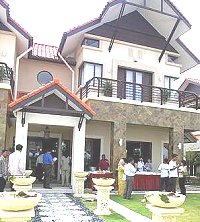Gated community getting popular
13/09/2004
The Star By S.C. Cheah
JUST when the gated community concept is gaining
wider acceptance, some people claim that such exclusive living may
create “social apartheid” in our country.
With numerous crimes reported daily, I am sure
most of us would choose to live in a gated community where we can
have better protection. However, as most of these niche projects are
rather expensive, most of us cannot afford to buy them and pay the
monthly maintenance charges that can be as high as RM1,000 for a
very high-end bungalow project.
Security is uppermost on people's minds these days
and they are prepared to pay more for their homes if they can be
assured of some form of security. Why envy them if they can afford
to own such homes?
Even if there are no gated communities, there is
no guarantee that there would be better social integration. How
often do you see the wealthy folks bringing their children to a
low-cost area and allowing them to mix with the poorer kids in a
normal township?
This brings me to the mixed development concept
that became the trend during the 1980s and 1990s. Although this
concept has its advantages, there were also shortcomings.
|
 |
A show unit of the Damansara Idaman phase
2 project by TA First Credit Sdn Bhd, which is a gated
community
|
Selling a mix of residential, commercial and
industrial properties has always been a part of strategic township
planning.
Usually developers would bring in the population
first by building affordable homes such as low and low-medium cost
houses and flats.
They would then build a few rows of shop houses.
As more people move in, they would launch the town centre and sell
more office and retail units. The industrial units would follow
suit.
The idea behind building industrial and commercial
units is partly to create more economic activities in a township.
Some developers even build apartments beside the
factories to provide accommodation to the workers. They would also
build some high-end homes such as bungalows for the factory bosses
and then get them to buy the apartments for their workers to stay.
Townships with lots of amenities and facilities
such as a wet market, multipurpose hall, town centre and shopping
centres may provide the opportunity for residents to meet, but more
often than not, people tend to keep to themselves.
One of the flaws of a mixed development is when a
portion of it looks like a “ghost town”. This may happen when
factories and shop houses are not occupied or remain unsold for
years. This encourages vandals to move in.
Social interaction takes a backseat and people
become concerned about security. Developers saw this need for
security and that's why the gated community concept is flourishing
these days.
There are also many mixed townships where the
low-cost residential units are cast in an obscure corner and look
very rundown. At the other extreme, you have bungalows standing side
by side with low-cost flats.
Examples include the Saujana Akasia bungalow
project in Sungai Buloh that is next to some low-cost flats built by
another developer and the high-rise, low-cost flats in Pelangi
Damansara that are next to many pricey houses and condominiums in
the very prime PJU area where projects such as the Mutiara Damansara
and Palm Spring @ Damansara as well as Tesco, Ikano Power Centre,
and Ikea are located.
A recent check showed that these low-cost
apartments are crammed and there is hardly enough car parking space
for the residents.
One wonders whether these residents mix with each
other. The value of a high-end property may be adversely affected if
its image is marred by an adjacent low-cost project, especially one
that is poorly maintained.
Is it fair to expect people who have paid, say
RM1mil to RM2mil for a bungalow, to stay in an area that may not
reflect a kind of exclusivity?
There have been suggestions that low-cost
residential units can be built in a nicely planned and designed
environment to give them a better image. The creation of pathways
can link them to the higher priced properties that are gated
communities. Neighbourhood parks and social activities can still
help to bring the residents together.
Some developers are already experimenting with the
concept of multiple gated communities within their development. They
are bringing this concept to a more affordable level where terrace
houses in each precinct have their gated communities.
Developers are throwing in landscaped parks, nice
streetscapes and other facilities to foster greater social
interaction within these communities.
Such gated communities for the masses can bolster
social and racial harmony if properly planned and managed.
There are other issues involved. Many so-called
gated communities are, in fact, not exclusively gated, as the common
areas such as internal roads and vacant land within the development
do not belong to the residents.
Legally it has been argued that outsiders can
still demand access into the development.
|